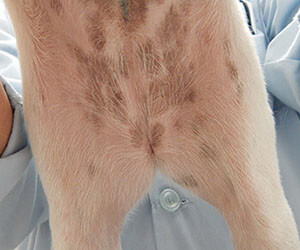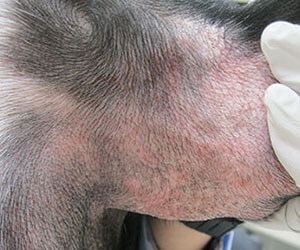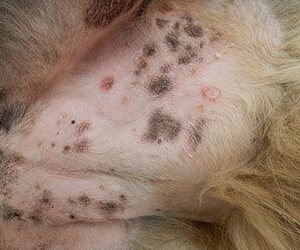Does My Dog have Recurrent Staph Skin Infection?
There are several stages to skin infection The infection often begins on the superficial layers of the dog’s skin, with minor skin irritation and small sores typically seen first. However, symptoms can also include pustules, small raised lesions, crusting, round sores, and hair loss. In a deeper form once the infection has set in, the damage to the dogs wellbeing is also more severe and can including bleeding sores and furuncles (boils).
Early Stages.
Early in the course of allergic disease, many dogs will have few or no lesions, though itch may be severe. This dog’s abdomen is erythematous and very pruritic, though secondary infection has not set in yet.

Inflammation.
As inflammation and self-trauma persist, there is increasing alopecia and erythema, along with the beginning signs of superficial pyoderma. This dog’s axilla is developing numerous small erythematous papules suggestive of early infection, though overt pustules have not yet developed.

Infection Established.
As the staphylococcal infection becomes firmly established, pustules begin to appear, as shown on this dog’s abdomen.

Infection Progresses.
As the infection progresses, the pustules enlarge and rupture, creating focal crusted lesions and spreading out to form circular “epidermal collarettes.”

Acute Infection.
As the epidermal collarettes heal, they often become hyperpigmented in the center. Note in this dog many circular black “spots” indicating healed former collarettes, some collarettes in the process of healing, and some that appear to be just forming. In this case, we can say that the superficial staphylococcal infection has been present for some time.

Images ©University of Wisconsin
Are you offering Staphage Lysate?
Find out how you can offer this effective solution to your clients.
